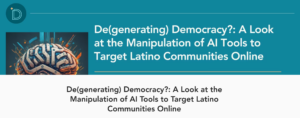AI Targeting Latine Voters
We’ve known since the advent of modern AI tools that they were built with implicit biases that often reinforce racist and otherwise bigoted narratives. AI companies have assured us that they’ve been working diligently to overcome that (as I discussed in this previous blog post), but it’s a difficult problem to tackle.
AI Disinformation is a Global Problem
As troubling as AI has been for disinformation in the English-speaking world, the problem is even more pronounced for those who don’t speak English–and in case you need a reminder, that’s a lot of people (around 66 million Americans default to a language that isn’t English). That’s without even going into the problem of disinformation globally.
One of the groups historically most targeted by disinformation in the US is Latine people.
Let me add a clear caveat here: the issue is not that Latine people experience a greater degree of “susceptibility” to these narratives–that is a racist framing that is often employed to paint Latine people in a negative light. Equis Research conducted an extremely enlightening study that showcases the pitfalls of disinformation as it pertains to Latine people in the US, and they very intentionally highlight the fact that Latine people are no more or less susceptible to such narratives than anyone else. The greatest issue, they found, is one of trust, not of competence.
New Research on AI Disinformation Targeting Latine Voters
And that brings me to the main goal of this post: to discuss a new study from the Digital Democracy Institute of the Americas (DDIA) that examines how AI tools are being used to target Latine voters with disinformation.

Alt Text: A screenshot of the headline of the DDIA article “De(generating) Democracy?: A Look at the Manipulation of AI Tools to Target Latino Communities Online”
“De(generating) Democracy?: A Look at the Manipulation of AI Tools to Target Latino Communities Online” documents a series of experiments conducted by the DDIA on Chat-GPT and DALL-E designed to test the effectiveness of their recently instated policies that were put in place to prevent the misuse of their tools to target Latino voters ahead of US elections.
The study had many illuminating results, but the two standouts are, as highlighted by DDIA:
- Basic prompts related to building a chatbot to target Latino voters in the United States resulted in detailed instructions from GPT-4.
- The tests involving the creation of images for political purposes using DALL-E showed the model’s content policies could be bypassed by avoiding explicit references to real individuals.
Essentially what that means is that what policies do exist for these companies are easily bypassed, meaning there is basically no effective stopgap in using Chat-GPT or DALL-E for the specific purpose of generating disinformation to target Latine voters. In fact, the tools will provide you an entire strategy to do so.
The study offers many takeaways, and I encourage you to read the entire thing. As it’s a research project, it is a bit dense, but it’s not overly long, and it is extremely illuminating.
What the DDIA Wants You To Understand
As with any post on AI I share, I want to be clear that my goal is not to fearmonger. AI is a tool, and as such, it can be shaped.
The DDIA agrees:
“Addressing these risks demands a multifaceted approach. While technical improvements in AI moderation are necessary, they must go hand-in-hand with societal interventions. Investments in digital literacy, strengthening protections against discrimination and bias through updated legislation, and fostering trust and communication between citizens and democratic institutions are also crucial. Ultimately, combating AI misuse and abuse requires recognizing its connection to deeper societal challenges and a willingness to take action on both the technological and societal fronts.”
Building an ethical AI landscape is incredibly difficult. But the reality is that a lot of very educated, very talented people have worked extremely hard to give us the tools to make it a reality. We need to ensure that our leaders listen to them.